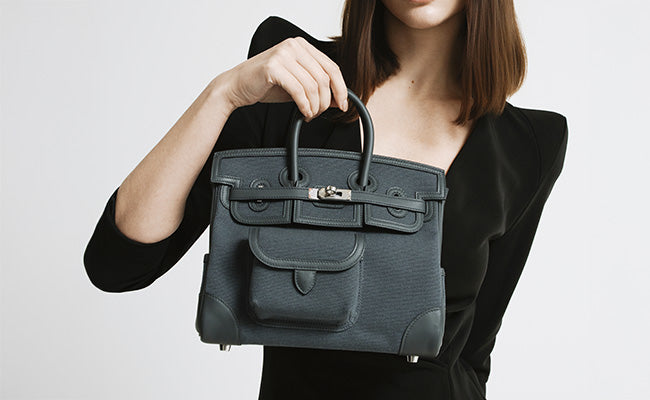
How to Take Care of Hermès Bags
Check out our Hermès collection and Birkin bags!
Owning a Hermès bag puts you in a pretty exclusive club. These aren’t just accessories, they’re investments that can outlast trends and even generations.
Whether you’ve finally gotten your hands on a Birkin or you’re adding a Kelly to your shelf, learning how to keep these beauties in top shape is crucial if you care about their looks (and let’s be honest, their value).
The trick with Hermès bags is that every material has its own quirks. The pebbled Togo leather? Super forgiving. Delicate crocodile? Not so much. What keeps a Garden Party canvas fresh could absolutely wreck a Box Calf Kelly, so the details matter more than you’d think.
We’ve all heard the stories, bags ruined by cleaning hacks gone wrong, or by tossing them in a closet without a second thought. The upside? With the right habits, caring for your Hermès collection isn’t rocket science. A little know-how and a bit of consistency are all it takes, and soon it’ll just feel like part of your routine.
Key Takeaways
- Handle humidity and light: store stuffed upright in dust bags, hardware facing up, and keep away from heat, moisture, and direct sun.
- Material matters: exotics need a feather-light touch and absolutely no water. Togo and Clemence are daily drivers, while smooth leathers (Swift/Box) need gentler handling.
- Interior spot-care only: for a tiny mark inside a calf-leather lining, dab with distilled water on a very dry, clean towel. Avoid liquids on the exterior.
Understanding Hermès Bag Materials
Hermès uses over 50 materials for their iconic bags, and each one has its own personality. Full-grain leathers show off veins and pores, while exotics and canvas bring unique textures and vibes.
Classic Hermès Leathers Explained
Togo and Clemence are the everyday heroes. Both have a pebbled grain that’s great at hiding scratches, though they get a slouchy look as they age.
Togo is firmer and holds its shape better. Clemence feels softer and leans casual. Both are solid picks for daily use.
Swift and Box Calf are all about old-school glam. Swift is soft with a subtle shine. Box Calf is structured and glossy, but it’ll show every little scratch.
These smooth leathers look incredible but can be unforgiving if you’re rough with them.
Epsom is the neat freak of the bunch. Its crosshatch texture keeps it crisp and it resists surface wear well.
Note: Although more water-resistant than most leathers, the exterior should remain free from any moisture.
All these leathers develop patina as they age. Marks and little quirks aren’t flaws. They’re proof your bag is real and has a story.
Exotic Leathers and Rarity
Hermès exotics are the ultimate flex. Crocodile comes in Porosus (tiny, even scales) and Niloticus (bigger, more random ones).
Both types can have a glossy finish that catches the light and makes every bag unique. The scales give each one its own fingerprint.
Alligator is similar, with slightly different scale shapes; American alligator has more rectangular belly scales.
Lizard is a more “entry-level” exotic. The tiny scales feel almost like fabric, but it’s more fragile than croc or gator.
Warning: Do not get exotics wet and do not “wipe them down” with liquids, even tiny droplets can leave permanent tide marks. Keep conditions steady and leave cleaning to Hermès or an approved expert.
| Exotic Type | Scale Pattern | Durability | Rarity Level |
|---|---|---|---|
| Porosus Crocodile | Small, symmetrical | Excellent | Extremely high |
| Niloticus Crocodile | Larger, irregular | Excellent | Very high |
| Alligator | Rectangular belly | Very good | High |
| Lizard | Tiny, uniform | Moderate | Moderate |
Canvas, Toile H, and Other Materials
Canvas bags like the Garden Party are practical and still totally luxurious. They’re light, tough, and don’t mind a little mist, but don’t soak them.
Canvas gets character with age, scuffs and patina just add to the story.
Toile H is Hermès’ signature coated canvas with an “H” weave, bridging business and casual.
You’ll also see felt, raffia, wool, and tech fabrics pop up. These are more seasonal or lifestyle-driven, canvas for the beach, felt for autumn, tech for active days.
Lillian’s stance: non-leather materials still don’t need sprays or “treatments.” Spot clean gently and keep moisture controlled.
Essential Daily Care Habits
Day-to-day care for Hermès bags is pretty straightforward: handle them gently, clean with the right stuff, and protect the parts that get the most action. These habits go a long way to keeping your bag looking luxe.
Proper Handling to Prevent Wear
Treat your Hermès bag like it’s precious, because it is. Always lift from the body, not just the handles, which can stretch or weaken over time.
Quick handling tips:
- Use both hands for big bags like Birkins.
- Don’t overstuff, keep the shape.
- Skip tossing sharp or odd-shaped things inside.
Lillian's Note:
“When placing the bag during use, please keep it in a vertical position to help maintain its structure. For storage, however, please lie the bag flat in a resting position. This ‘sleeping pose’ allows the leather to relax and naturally restore its shape over time, especially for larger bags.”
Use of Microfiber Cloth for Cleaning
A dry microfiber cloth is your daily hero. Gently buff away dust, fingerprints, and smudges that show up during use.
- Use gentle, circular strokes. Switch to a clean section for hardware.
- Pay extra attention to handles and closures.
- Avoid water and commercial cleaners on exteriors, as they are not recommended for Hermès leathers.
Protecting Handles and Hardware
Handles are magnets for oils and grime. Twilly scarves aren’t just cute, they protect handles, too.
- Wrap Twillys around handles and switch them up now and then.
- Wash hands before handling, keep lotions/perfume/makeup away from leather.
- Wipe hardware dry with microfiber, avoid knocks and moisture.
Maintaining Exotic Skins
Crocodile, alligator, and lizard are high-maintenance and prone to permanent water marking.
- Gently remove surface dust with a soft, dry microfiber cloth.
- Keep exotic skins completely dry, as water marks are often permanent.
- Maintain stable humidity (40–50%) and protect from heat and direct light.
- For any issue, stain, dryness, color, contact Hermès Spa.
Using Dust Bags and Pillows
- Store the bag in its dust bag, using acid-free tissue or a soft pillow to maintain its shape (don’t overstuff).
- Remove lock, keys, clochette, place them in their dust covers inside.
- Use the felt protector to shield hardware/flaps from rubbing.
- Store detachable straps separately in their protective cover.
Shielding from Sunlight and Humidity
- Keep away from direct sun and harsh lights to prevent fading and drying.
- Use silica packets nearby (not touching leather).
Seasonal and Preventive Maintenance
Weather and seasons can mess with your Hermès bag, so tweak your routine as needed. Sometimes, it’s worth letting the professionals handle a refresh, at Hermès.
Exotics: prioritize stable conditions year-round. They’re the first to show cracks and water marks from environmental swings.
Using Rain Protectors and Accessories
Until 2024, many Hermès bags included clear rain covers. If your bag is older, check your accessories, you may have one.
- If you use a cover, use it briefly and let the bag breathe afterward. Don’t use plastic bags as makeshift covers.
- Twilly scarves help shield handles from oils and light moisture.
- If the bag gets caught in the rain, gently blot it with a clean, microfiber cloth and let it air dry away from heat. For exotic leathers, avoid any contact with moisture on the scales, and if marks appear, contact Hermès, as they may be permanent.




